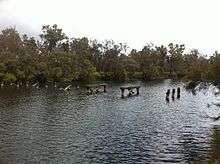Blackwood River
| Blackwood River | |
|---|---|
 Colour Patch area at mouth of Blackwood river and start of eastern section of estuary | |
| Country | Australia |
| Basin features | |
| Main source |
Junction of Arthur River and Balgarup River 219 metres (719 ft)[1] |
| River mouth |
Hardy Inlet, Augusta sea level |
| Basin size | 28,100 km2 (10,849 sq mi)[2] |
| Physical characteristics | |
| Length | 300 kilometres (186 mi)[3] |
| Discharge |
|




The Blackwood River is a major river and catchment in the South West of Western Australia.
Course
The river begins at the junction of Arthur River and Balgarup River near Quelarup and travels in a south westerly direction through the town of Bridgetown then through Nannup until it discharges into the Southern Ocean at Hardy Inlet near the town of Augusta.
Hardy Inlet has a number of islands – namely Molloy Island and Thomas Island. The mouth of the river has attracted interest in its various points of opening and closing over the last 100 years, Duke Head at the west side being a benchmark location for the shifting mouth.
The river has 41 tributaries including Dinninup Brook, Balingup Brook, St John Brook, Boyup Brook, Tweed River, Ti Tree Gully, Christmas Creek and Tanjannerup Creek.[1]
Catchment
The river has a total catchment area of 28,100 square kilometres (10,849 sq mi) stretching from Kukerin in the east to Hardy Inlet in the west,[2] and from Darkin in the north to Augusta in the south.[5]
Several major towns are found within the catchment including Katanning, Narrogin, Bridgetown and Nannup.
The upper or larger catchment area of the river is in agricultural areas, while the middle catchment area passes through forest areas, and the lower portion of the river passes into mixed forest, agricultural and residential lands. The river emerges into Flinders Bay at Augusta.[2]
The majority of the basin, 78%, is devoted to Agriculture including ceral production and grazing. There are still many significant water resources including over 1,000 wetlands, as well as the river itself.[5]
The basin is habitat for an estimated 8,000 species of flora including three threatened ecological communities. A total of 42 rare and priority vertebrate fauna species and 143 rare and priority flora species are found within the basin catchment area.[5]
Bridges
Occur where the river passes through localities and towns, as well as isolated bridges at places like Alexander Bridge.
History
It was discovered in 1827 by Captain James Stirling and named by Stirling after Vice-Admiral Sir Henry Blackwood, under whom he served as a Midshipman on HMS Warspite in 1808–1909 during the Napoleonic Wars, in the North Sea and the Mediterranean.[6]
Historically it was of considerable importance in the early days of the Swan River Colony, and more recently of importance in the ecology of the Augusta-Margaret River region due to conflicts in land use policy. The upper catchment contains Toolibin Lake, a nature reserve and Ramsar site.
The river is prone to occasional flooding. In 1945 it rose to the highest level recorded to that date, running 1.1 metres (3.6 ft) over the Russell Street bridge in Nannup.[7] The river flooded again in 1946 and 1947 closing roads but not causing any significant damage to towns along the river.[8] In 1949 Nannup received 174 millimetres (6.85 in) of rain in a period of seven hours, causing flooding. A bridge over the Blackwood connecting the town to Busselton was swept away.[9]
In 1982 after the remnants of a Tropical cyclone passed through the southwest, the town and surrounding areas were inundated by heavy rains. The Blackwood rose 11.6 metres (38 ft), submerging over 50 houses in Nannup.[10]
References
- 1 2 "Bonzle Digital Atlas – Map of Blackwood River, WA". 2008. Retrieved 23 November 2008.
- 1 2 3 "Waters and Rivers Commission – Ribbons of Blue – Blackwood Region". 2004. Archived from the original on 4 July 2007. Retrieved 26 July 2007.
- ↑ Western Australian Land Information Authority. "History of river names". Archived from the original on 16 February 2015. Retrieved 4 August 2008.
- ↑ "Water Corporation – Ecological water requirementa of Blackwood Riverand tributaries" (PDF). 2007. Archived from the original (PDF) on 8 September 2007. Retrieved 26 July 2007.
- 1 2 3 "Blackwood". South West Catchments Council. Retrieved 3 October 2016.
- ↑ Western Australian Parliamentary Library (March 2005). "Origins of Legislative Assembly Electoral Division Names" (pdf). Government of Western Australia. Retrieved 12 Dec 2013.
- ↑ "Nannup Flood". The West Australian. Perth: National Library of Australia. 2 July 1945. p. 4. Retrieved 8 April 2013.
- ↑ "Floods at Nannup.". Kalgoorlie Miner. Western Australia: National Library of Australia. 23 June 1947. p. 4. Retrieved 8 April 2013.
- ↑ "Heavy Rainfall Floods W.A. Town.". The Mercury. Hobart, Tasmania: National Library of Australia. 28 April 1949. p. 20. Retrieved 9 April 2013.
- ↑ "Floods bring havoc to the south west.". The Australian Women's Weekly. Sydney: National Library of Australia. 17 February 1982. p. 4. Retrieved 8 April 2013.
Further reading
- Brearley, Anne, Ernest Hodgkin's Swanland : estuaries and coastal lagoons of South-western Australia Crawley, W.A. : University of Western Australia Press for the Ernest Hodgkin Trust for Estuary Education and Research and National Trust of Australia (WA), 2005. ISBN 1-920694-38-2
- Muirden, Peter: Pen, Luke and Marnie Leybourne (2003) Stream and catchment hydrology in South West Western Australia Perth, W.A. Dept. of Environment. Department of Environment river restoration, 1442-6919 ; report no. RR19 ISBN 1-920849-24-6
- Pen, Luke J.(1999) Managing our rivers : a guide to the nature and management of the streams of south-west Western Australia (editor, June Hutchison) East Perth, W.A. : Water and Rivers Commission. ISBN 0-7309-7450-2
Coordinates: 34°19′S 115°11′E / 34.317°S 115.183°E